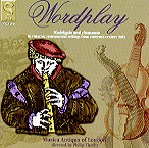Following a long tradition–one that thrives today–of re-setting original vocal works for various instrumental solos or ensembles, the early music group Musica Antiqua of London chooses six madrigals and chansons from 16th century Italy and presents them anew, applying as closely as possible performance guidelines spelled out in contemporary treatises. One such “instructional manual” is Sylvestro Ganassi’s La Fontegara. Published in 1535, it gives highly detailed directions specifically for recorder playing and how it should conform to the ideal expressive capacities of the human voice. Indeed, in certain exalted musical circles during this time, it was the voice–and the words it was capable of articulating–that was regarded as the most perfect vehicle for musical expression. Thus, director Philip Thorby and his colleagues apply lots of ornamentation, improvisatory runs and chordal flourishes, trills, vibrato effects, and timbral and dynamic variations to their multiple renditions of tunes such as La Spagna, Ancor che col partire, and Susanne ung jour. They also deliver a more or less straight reading of Adrian Willaert’s madrigal Cantai or piango in a setting for six viols–this followed by a brilliant improvisatory rendition of the same piece for solo recorder (played by Thorby) accompanied by lute. There’s a lot of variety among the arrangements as the players intelligently and with no small degree of musicological authority employ various viols, recorders, lute, and chamber organ. And much of the music is quite affecting, especially the two viol consort pieces, led by the outstanding Alison Crum. No, this probably doesn’t rank as an essential recording, even for early music specialists, but the high standard of playing, the thoughtfulness of the programmatic choices, and the tasteful interpretations make for satisfying entertainment and a worthy venture off well-worn traditional paths. The sound, from the National Centre for Early Music in York, England, is excellent, too. [10/8/2001]
































